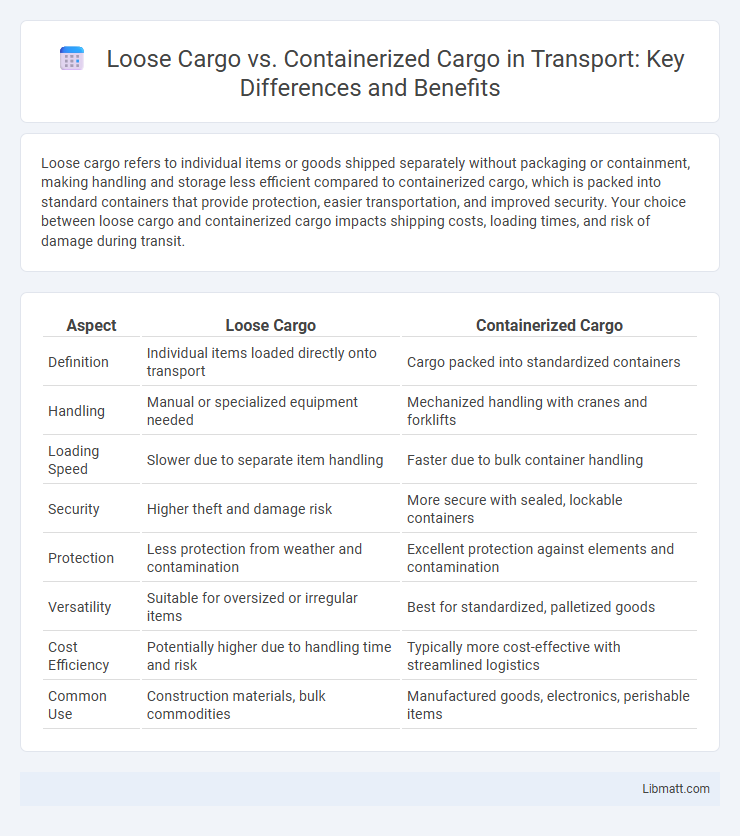Loose cargo refers to individual items or goods shipped separately without packaging or containment, making handling and storage less efficient compared to containerized cargo, which is packed into standard containers that provide protection, easier transportation, and improved security. Your choice between loose cargo and containerized cargo impacts shipping costs, loading times, and risk of damage during transit.
Table of Comparison
| Aspect | Loose Cargo | Containerized Cargo |
|---|---|---|
| Definition | Individual items loaded directly onto transport | Cargo packed into standardized containers |
| Handling | Manual or specialized equipment needed | Mechanized handling with cranes and forklifts |
| Loading Speed | Slower due to separate item handling | Faster due to bulk container handling |
| Security | Higher theft and damage risk | More secure with sealed, lockable containers |
| Protection | Less protection from weather and contamination | Excellent protection against elements and contamination |
| Versatility | Suitable for oversized or irregular items | Best for standardized, palletized goods |
| Cost Efficiency | Potentially higher due to handling time and risk | Typically more cost-effective with streamlined logistics |
| Common Use | Construction materials, bulk commodities | Manufactured goods, electronics, perishable items |
Introduction to Loose Cargo and Containerized Cargo
Loose cargo refers to individual items or bulk goods transported without packaging or containers, commonly used for large or irregularly shaped shipments like machinery or raw materials. Containerized cargo involves goods securely packed in standardized containers, enhancing protection, handling efficiency, and compatibility with various transport modes. Understanding the differences helps you optimize shipping methods based on cargo type, volume, and destination requirements.
Key Differences Between Loose Cargo and Containerized Cargo
Loose cargo consists of individual items shipped without packaging in containers, requiring manual loading and unloading, which increases handling time and risk of damage. Containerized cargo is securely packed within sealed containers, offering enhanced protection, standardized handling, and streamlined transportation across various modes. Understanding these key differences helps you choose the most efficient and cost-effective method for your shipping needs.
Advantages of Loose Cargo Shipping
Loose cargo shipping offers significant flexibility in handling oversized or irregularly shaped goods that do not fit standard container dimensions, making it ideal for heavy machinery and construction materials. It reduces packaging costs and allows for easier loading and unloading using cranes or forklifts, optimizing port operations and saving time. Your shipments benefit from streamlined logistics when dealing with bulk commodities or project cargo, enhancing overall supply chain efficiency.
Benefits of Containerized Cargo Transport
Containerized cargo transport enhances security by reducing theft and damage through sealed containers, ensuring goods remain intact from origin to destination. It improves efficiency in handling and logistics, as standardized containers allow for faster loading, unloading, and stacking, reducing transit time and operational costs. The standardized nature of containers also facilitates multimodal transport, seamlessly integrating ships, trucks, and trains for global supply chain optimization.
Common Types of Loose Cargo
Common types of loose cargo include bulk commodities such as coal, grain, and minerals that are transported without packaging, enabling quick loading and unloading processes. Breakbulk cargo like steel coils, lumber, and machinery often falls under loose cargo, requiring specialized handling to prevent damage. Understanding these distinctions helps optimize your shipping strategy by selecting appropriate transportation methods for different loose cargo types.
Typical Goods for Containerized Shipping
Typical goods for containerized shipping include electronics, clothing, furniture, and manufactured consumer products that benefit from secure, standardized packaging. Containerized cargo ensures protection against damage, weather, and theft, making it ideal for high-value and fragile items. This method also facilitates efficient handling and intermodal transport across ships, trucks, and trains.
Handling and Loading Procedures
Loose cargo requires manual or specialized handling equipment such as cranes, forklifts, and slings for loading and unloading, often involving individual item management and careful stacking to prevent damage. Containerized cargo simplifies loading procedures by consolidating goods into standardized containers, enabling efficient handling with gantry cranes and reducing the risk of cargo shifting during transit. The standardized dimensions and secure sealing of containers improve operational speed and protection compared to the more labor-intensive process of handling loose cargo.
Security Considerations in Cargo Transport
Loose cargo exposes shipments to higher risks of theft, damage, and contamination due to its unprotected state during transport, leading to increased security vulnerabilities. Containerized cargo offers enhanced security through sealed, lockable containers that prevent unauthorized access and reduce handling incidents. Furthermore, container tracking technologies improve monitoring and accountability, minimizing loss and ensuring safer logistics operations.
Cost Comparison: Loose vs Containerized Cargo
Loose cargo shipping often incurs higher handling and labor costs due to its irregular shapes and sizes, leading to increased loading and unloading times. Containerized cargo benefits from standardized containers that streamline handling procedures, reducing labor expenses and minimizing damage risks, resulting in more cost-effective logistics. While initial container rental fees may be higher, the overall efficiency and reduced insurance costs make containerized shipping more economical for long-term or bulk shipments.
Choosing the Right Shipping Method for Your Cargo
Loose cargo offers flexibility for irregular or oversized items that do not fit into standard containers, making it ideal for heavy machinery or construction materials. Containerized cargo provides enhanced security, streamlined handling, and protection from weather, which suits high-value or sensitive goods. Evaluating your cargo's size, fragility, and delivery timeline helps determine the most efficient and cost-effective shipping method.
loose cargo vs containerized cargo Infographic

 libmatt.com
libmatt.com